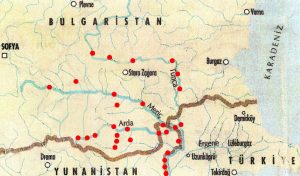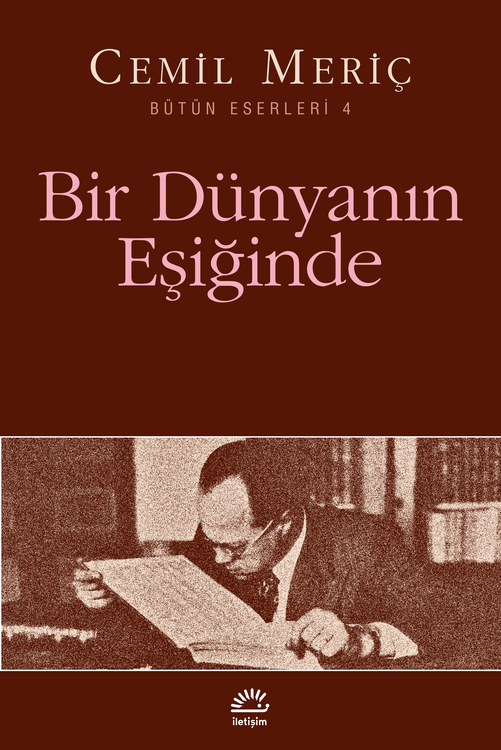The first Sinologist, Tonyukuk 716, was born in China, he internalized China.
From 646 to 2016, 1370 years of Sinology is a synthesis of East (Chinese Indian) West (Rumi) that met with our line of thought in Indology, Cemil Meriç, and the Occidental school in Rumeli Dimetoka. Our high flow cascade from the Orhun, Indus, Ganges and Meriç rivers carried us from the steppes to the waterside.The Westerners, on the other hand, named their plundering journeys to exploit Indian resources as much as possible, and named the robbers as Explorers, and named the Asian Indian people they encountered as Indians.
Cemil Meriç is our greatest Westerner. While researching the foundation of Western Civilization, he came across Hind and devoted his first book to Hind; Indian Literature (1964).
So the starting point of Occidentalism is in India and China; It is necessary to be a connoisseur in Indology and Sinology.
It never occurred to the Young Turks and their successors to look at Europe from India.
While Europe went to Indian sources, we turned to European sources.
Civilization structures that the Turks encountered as a result of their journeys that lasted for millennia; Together with China, India, Iran, Islam and Rum, they gifted a Civilization Alliance to humanity, and Westernization means adding the missing piece of Western (Europe) to this alliance.
The most refined meanings and interpretations of Çini, Hindi and Rumi found their meaning in the Alliance of Civilizations formed by the Turks.
Westernization, in this sense, is actually a geographical orientation that the Turks stubbornly and resolutely followed, that the ancient Greeks (Ionia), Old India (Gazneli, Timur, Mughal) and Islam (Khorasan, Transoxiana, Mesopotamia, Andalusia) that the West was fed spiritually have always been. Its synthesis was transferred to the West and created by the Turks.
Kitab al-Muhtasar fil Hisab al-Hind , the first work written on the Indian account of Muhammad b. It is the Kitâbü’l-Ĥisâbi’l-Hindî by Mûsâ al-Harizmî (d. 232/847). The most important feature of the work is that for the first time in the Islamic world, Indian numerals and the decimal numeral system were used together with zero. Western mathematicians learned to use the positional and ten-based Indian calculus instead of the calculus system they have been using since the Roman period, and they named this system “algorism”, which they derived from the name of Hârizmî.

Hellenism, which was imposed as a state policy through İnönü, broke the Turks from their historical roots. Cemil Meriç’s Corpus of India
- mainland-Anatolia
- indology
- Historical Line
- Our States in India
- Turks and India
- Turkish World and Indian World
- Altai-Aryan
- Tongue
- Islamp
- mysticism
- Naqshbandiyyah
- Assyrians
- Catholicism
- Independence War
- Regional Alliance of Powers
- INTERland
- ASAM
- Works of Our Orientalists..Hindology
- Sek-i Hindi
- Our Foreign Trade
- Suggestions
- Roads
- Indo-European
- Tamil-Turkish
Let’s ensure our loyalty and permanence to our monumental, transcendent thinkers, which started with Tonyukuk and crowned with Cemil Meriç, with doctorates. Our Thought Journey, which was started by the wise Tonyukuk with the Stone Inscription on the edge of the Orkhon river in the far East, with the Last Thinker Cemil Meriç’s Collection of volumes in the westernmost part of the Meriç; By discovering the East within the West, he united both worlds through our Civilization.While the dark gladiators with the title AYDIN darken the agenda, AMA (blind) Cemil Meriç, on the 100th anniversary of his birth, illuminates our millennials.
http://leventagaoglu.blogspot.com.tr/2016/11/bilge-tonyukuk-yazlar.htmlSo these are the main poles.East West North South.
Four-Pole Civilization..
Starting with the first thinker Tonyukuk, the Mission in the axis of the Last Thinker Cemil Meriç is an important service that should be done to the country in terms of directing to the right resources.
Tonyukuk grew up with the Chinese culture and Cemil Meriç grew up with the French culture, but they are locals.
They are neither Chinese nor French.
We need to show this to our people.
“Understanding the thinkers is possible by first identifying where and how they are positioned. Cemil Meriç, deep Muslim era (1917-1925), chauvinistic nationalism era (1925-1936), socialist era (1936-1938), purgatory era (1938-1960), Hindu era (1960-1964), only Ottoman era (1964) During the years of intellectual transformation he lived with the stages of -) he made an effort to position himself in this world as an intellectual with an inquiring, questioning and criticizing understanding. In this study, considering Meriç’s thought stages, the concepts of “place” and “nativeness” will be discussed first, and then the reflections of the idea of ”nativeness” in the mental world of the writer, who is an intellectual worker, will be emphasized. http://edebiyat.gumushane.edu.tr/user_files/files/Sempozyum.pdf
WE DON’T KNOW INDIA. He started to bring us news with his works “Indian Literature” published in 1964 and “On the Verge of a World” published in 1976.
- “We don’t know Indian. The Turk, who gifted that country its greatest ruler, does not know the Indian. We don’t know Indian. Despite Akbar, we do not know. While Sebük Tekin’s son was making Hezarbütgede a mosque, Elbiruni carried his intellectual treasures to the East, compared Greek philosophy with the philosophy of the Himalayan sages, and fused Islamic Sufism with Indian Sufism. Despite Elbiruni, we do not know Hint.” Cemil Meric; Journal I, Communication Publications, 8th Edition, 1998, Istanbul, p.147
- We have to know India There are two creative nations that guide humanity’s wisdom and understanding: Indian and Greek… We are at the center of these two countries. The Mediterranean is the juncture of East and West… We don’t know Hint, Journal p. 150
- “The incarnation of our intellectuals has never been able to reach the peak of the Himalaya.” Cemil Meric; On the Verge of a World, İletişim publications, Istanbul, 2010, p.85
- “We have to get to know India, because Sufi sufism, which is the culmination of Islamic contemplation, came out of that country. Our forefathers were Buddhists before they converted to Islam. We have to know Indian. The basis of Asian thought is Indian thought. We have to know Indian. There are two creative nations that guide humanity’s wisdom and understanding. Indian and Greek.. We are in the center of these two countries. The Mediterranean is the juncture of East and West. Humanity is in the grip of a terrible depression. Thousands of years of harmony between Kosmos and anthropos has come to an end. Europe forgot itself while conquering matter. It is only thanks to Indian that we can reach the great composition that will make one find himself.” Journal I, p.147
- “India has become my second homeland because it is a country that gives a voice to all faiths” Journal I, p.370
- “Contemporary Europe is a continuation of India at its brightest. (…) The Greek miracle owes all its glory to Asia: Pythagoras, Democritus, Lykurgos lit their torches either on the banks of the Ganges or on the banks of the Nile.” Journal, p.374
- “The Indian took refuge in the castle of asceticism from the wrath of the elements. Dark colors predominate in Indian thought. India is the homeland of those who despise life. The spirit of the Indian, like the nature of the Indian, is an apocalypse of contradictions.” On the Verge of a World, p.90
- “The land of the Pharaohs is a magnificent pile of stones, the mammoths rising along the Euphrates are underground, Athens is a dream, Rome is a legend… The Indian has been around for five thousand years. If the Indian had tied his hands and lived in the world of dreams, how would that great civilization be born, how could it develop, how could it survive? On the Verge of a World, p.90
- “The greatest triumph of Indian thought is in its grasp of the unchanging” On the Verge of a World, p.89
- “You have watched the mountains, its architecture, the same majesty in both” On the Verge of a World, p.91
- “Even grammar and medical books are often in verse” On the Verge of a World, p.91
- The first country to be visited by those who conquer the world of thought should be India. The Indian gives the right to speak to all faiths. Contemporary Europe is a continuation of India at its brightest. Hint maybe not the whole truth , but the truth. This Country, p. 45
- While I was looking for Olemp, I came across Hint. This Country, p. 45
Cemil Meriç: On the Verge of a World
- Excerpts from the journal book
- Journal
- ‘Cemil Meriç on the 100th Anniversary of His Birth’ panel was held
- 100th Anniversary Panel





















